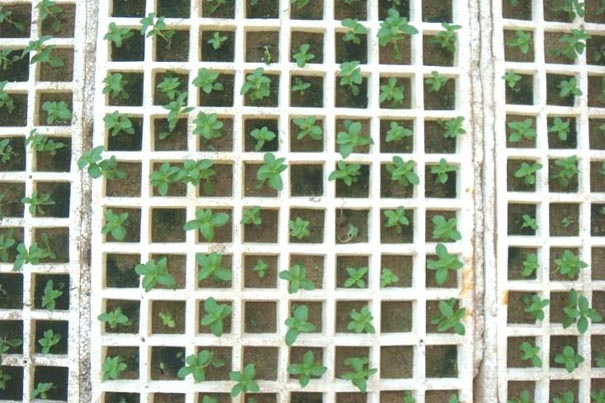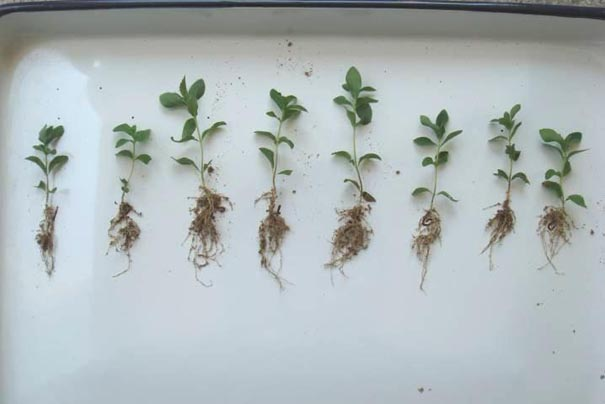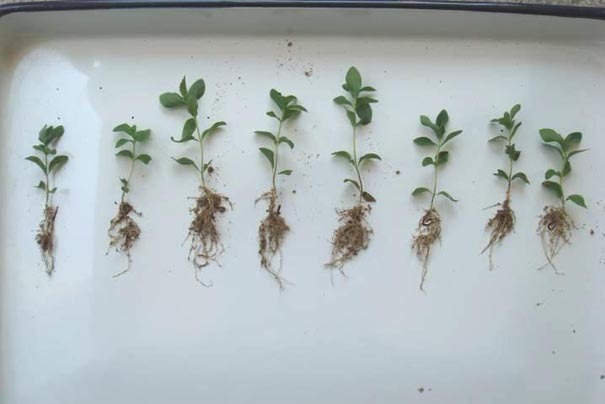Cuttage method of stevia rebaudiana rootless tissue culture seedling
A technology for stevia and tissue culture seedlings, applied in the field of plant tissue culture, can solve the problems of restricting the expansion, promotion and application of tissue culture technology, low cutting survival rate of tissue culture seedlings, low cutting survival rate, etc. Reliable and feasible, fast effect of tissue culture propagation
- Summary
- Abstract
- Description
- Claims
- Application Information
AI Technical Summary
Problems solved by technology
Method used
Image
Examples
Embodiment 1
[0042]A method for cutting stevia rootless tissue culture seedlings, the steps are as follows:
[0043] Take out the proliferating seedlings in the tissue culture bottle, cut off the cutting seedlings with a length of 3 cm, remove the two leaves at the base, and keep the leaf nodes; keep the stevia seedlings moist during the cutting process to prevent drying and wilting.
[0044] Cutting: Take a foamed plastic seedling tray, fill the hole with fine sand, punch holes, and insert seedlings; ensure that a leaf node is buried in the sand and compact the fine sand; water; install a bracket on the seedling tray and cover it with plastic film .
[0045] Seedling tray management: the seedling trays are placed directly in the open air in spring; the seedling trays are covered with sunshade nets when the temperature is high in summer, and the sunshade nets are removed on cloudy summer days; the shading rate of the sunshade nets is 80%.
[0046] Seedling hardening: 10-15 days after plan...
Embodiment 2
[0048] A method for cutting stevia rootless tissue culture seedlings, the steps are as follows:
[0049] Take out the proliferating seedlings in the tissue culture bottle, cut off the cutting seedlings with a length of 4 cm, remove the two leaves at the base, and keep the leaf nodes; keep the stevia seedlings moist during the cutting process to prevent drying and wilting.
[0050] Cutting: Take a foamed plastic seedling tray, fill the hole with fine sand, punch holes, and insert seedlings; ensure that a leaf node is buried in the sand and compact the fine sand; water; install a bracket on the seedling tray and cover it with plastic film ;
[0051] (3) Seedling tray management: Put the seedling trays directly in the open air in spring; cover the seedling trays with sunshade nets when the temperature is high in summer, and remove the sunshade nets in cloudy summer days; the shading rate of the sunshade nets is 80%.
[0052] (4) Seedling hardening: 10-15 days after planting, rel...
PUM
 Login to View More
Login to View More Abstract
Description
Claims
Application Information
 Login to View More
Login to View More - R&D
- Intellectual Property
- Life Sciences
- Materials
- Tech Scout
- Unparalleled Data Quality
- Higher Quality Content
- 60% Fewer Hallucinations
Browse by: Latest US Patents, China's latest patents, Technical Efficacy Thesaurus, Application Domain, Technology Topic, Popular Technical Reports.
© 2025 PatSnap. All rights reserved.Legal|Privacy policy|Modern Slavery Act Transparency Statement|Sitemap|About US| Contact US: help@patsnap.com



